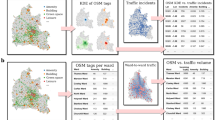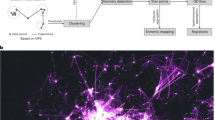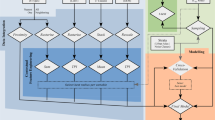Abstract
Living near traffic adversely affects health outcomes. Traffic exposure metrics include distance to high-traffic roads, traffic volume on nearby roads, traffic within buffer distances, measured pollutant concentrations, land-use regression estimates of pollution concentrations, and others. We used Geographic Information System software to explore a new approach using traffic count data and a kernel density calculation to generate a traffic density surface with a resolution of 50 m. The density value in each cell reflects all the traffic on all the roads within the distance specified in the kernel density algorithm. The effect of a given roadway on the raster cell value depends on the amount of traffic on the road segment, its distance from the raster cell, and the form of the algorithm. We used a Gaussian algorithm in which traffic influence became insignificant beyond 300 m. This metric integrates the deleterious effects of traffic rather than focusing on one pollutant. The density surface can be used to impute exposure at any point, and it can be used to quantify integrated exposure along a global positioning system route. The traffic density calculation compares favorably with other metrics for assessing traffic exposure and can be used in a variety of applications.
This is a preview of subscription content, access via your institution
Access options
Subscribe to this journal
Receive 6 print issues and online access
$259.00 per year
only $43.17 per issue
Buy this article
- Purchase on Springer Link
- Instant access to full article PDF
Prices may be subject to local taxes which are calculated during checkout




Similar content being viewed by others
References
Health Effects Institute. Traffic-related air pollution: A critical review of the literature on emissions, exposure, and health effects 2010 Retrieved 29 July 2012, from http://pubs.healtheffects.org/view.php?id=334.
Chen E, Schreier HMC, Strunk RC, Brauer M . Chronic traffic-related air pollution and stress interact to predict biologic and clinical outcomes in asthma. Environ Health Perspect 2008; 116: 970–975.
Gent JF, Koutrakis P, Belanger K, Triche E, Holford TR, Bracken MB et al. Symptoms and medication use in children with asthma and traffic-related sources of fine particle pollution. Environ Health Perspect 2009; 117: 1168–1174.
Holguin F, Flores S, Ross Z, Cortez M, Molina M, Molina L et al. Traffic-related exposures, airway function, inflammation, and respiratory symptoms in children. Am J Respir Crit Care Med 2007; 176: 1236–1242.
Juhn YJ, Qin R, Urm S, Katusic S, Vargas-Chanes D . The influence of neighborhood environment on the incidence of childhood asthma: a propensity score approach. J Allergy Clinl Immunol 2010; 4: e2.
Juhn YJ, Sauver JS, Katusic S, Vargas D, Weaver A, Yunginger J . The influence of neighborhood environment on the incidence of childhood asthma: a multilevel approach. Soc Sci Med 2005; 60: 2453–2464.
McConnell R, Islam T, Shankardass K, Jerrett M, Lurmann F, Gilliland F et al. Childhood incident asthma and traffic-related air pollution at home and school. Environ Health Perspect 2010; 118: 1021–1026.
McCreanor J, Cullinan P, Nieuwenhuijsen MJ, Stewart-Evans J, Malliarou E, Jarup L et al. Respiratory effects of exposure to diesel traffic in persons with asthma. N Engl J Med 2007; 357: 2348–2358.
Meng Y-Y, Wilhelm M, Rull RP, English P, Nathan S, Ritz B . Are frequent asthma symptoms among low-income individuals related to heavy traffic near homes, vulnerabilities, or both? Ann Epidemiol 2008; 18: 343–350.
Peretz A, Sullivan JH, Leotta DF, Trenga CA, Sands FN, Allen J et al. Diesel exhaust inhalation elicits acute vasoconstriction in vivo. Environ Health Perspect 2008; 116: 937–942.
Shankardass K, McConnell R, Jerrett M, Milam J, Richardson J, Berhane K . Parental stress increases the effect of traffic-related air pollution on childhood asthma incidence. Proc Natl Acad Sci USA 2009; 106: 12406–12411.
Wilhelm M, Meng Y-Y, Rull RP, English P, Balmes J, Ritz B . Environmental public health tracking of childhood asthma using California health interview survey, traffic, and outdoor air pollution data. Environl Health Perspect 2008; 116: 1254–1260.
Brauer M, Lencar C, Tamburic L, Koehoorn M, Demers P, Karr C . A cohort study of traffic-related air pollution impacts on birth outcomes. Environ Health Perspect 2008; 116: 680–686.
Pereira G, Nassar N, Cook A, Bower C . Traffic emissions are associated with reduced fetal growth in areas of Perth, Western Australia: an application of the AusRoads dispersion model. Australian and New Zealand J Public Health 2011; 35: 451–458.
Kim JJ, Huen K, Adams S, Smorodinsky S, Hoats A, Malig B et al. Residential traffic and children’s respiratory health. Environ Health Perspect 2008; 116: 1274–1279.
Künzli N, Kaiser R, Medina S, Studnicka M, Chanel O, Filliger P et al. Public-health impact of outdoor and traffic-related air pollution: a European assessment. Lancet 2000; 356: 795–801.
McDonald JD, Campen MJ, Harrod KS, Seagrave J, Seilkop SK, Mauderly JL . Engine-operating load influences diesel exhaust composition and cardiopulmonary and immune responses. Environ Health Perspect 2011; 119: 1136–1141.
Tonne C, Melly S, Mittleman M, Coull B, Goldberg R, Schwartz J . A case–control analysis of exposure to traffic and acute myocardial infarction. Environ Health Perspect 2006; 115: 53–57.
Weichenthal S, Kulka R, Dubeau A, Martin C, Wang D, Dales R . Traffic-related air pollution and acute changes in heart rate variability and respiratory function in urban cyclists. Environ Health Perspect 2011; 119: 1373–1378.
Gauderman WJ, Vora H, McConnell R, Berhane K, Gilliland F, Thomas D et al. Effect of exposure to traffic on lung development from 10 to 18 years of age: a cohort study. Lancet 2007; 369: 571–577.
Armitage JM, Cousins IT, Hauck M, Harbers JV, Huijbregts MAJ . Empirical evaluation of spatial and non-spatial European-scale multimedia fate models: results and implications for chemical risk assessment. J Environ Monit 2007; 9: 572–581.
Holmes N, Morawska L . A review of dispersion modelling and its application to the dispersion of particles: An overview of different dispersion models available. Atmos Environ 2006; 40: 5902–5928.
Kumar P, Ketzel M, Vardoulakis S, Pirjola L, Britter R . Dynamics and dispersion modelling of nanoparticles from road traffic in the urban atmospheric environment—a review. J Aerosol Sci 2011; 42: 580–603.
Pratt GC, Dymond M, Ellickson K, Thé J . Validation of a novel air toxic risk model with air monitoring. Risk Anal 2012; 32: 96–112.
Pratt GC, Wu CY, Bock D, Adgate JL, Ramachandran G, Stock TH et al. Comparing air dispersion model predictions with measured concentrations of VOCs in urban communities. Environ Sci Techno 2004; 38: 1949–1959.
Smit R., Ntziachristos L., Boulter P. . Validation of road vehicle and traffic emission models—a review and meta-analysis. Atmos Environ 2010; 44: 2943–2953.
Beckerman B, Jerrett M, Brook JR, Verma DK, Arain MA, Finkelstein MM . Correlation of nitrogen dioxide with other traffic pollutants near a major expressway. Atmos Environ 2008; 42: 275–290.
Fruin S, Westerdahl D, Sax T, Sioutas C, Fine PM . Measurements and predictors of on-road ultrafine particle concentrations and associated pollutants in Los Angeles. Atmos Environ 2008; 42: 207–219.
He M, Dhaniyala S . Vertical and horizontal concentration distributions of ultrafine particles near a highway. Atmos Environ 2012; 46: 225–236.
Kaur S, Nieuwenhuijsen MJ . Determinants of personal exposure to PM2.5, ultrafine particle counts, and CO in a transport microenvironment. Environl Sci Technol 2009; 43: 4737–4743.
Kittelson DB, Watts WF, Johnson JP, Remerowki ML, Ische EE, Oberdörster G et al. On-road exposure to highway aerosols. 1. Aerosol and gas measurements. Inhal Toxicol 2004; 16 (Suppl 1): 31–39.
Löndahl J, Massling A, Swietlicki E, Bräuner EV, Ketzel M, Pagels J et al. Experimentally determined human respiratory tract deposition of airborne particles at a busy street. Environ Sci Technol 2009; 43: 4659–4664.
McAdam K, Steer P, Perrotta K . Using continuous sampling to examine the distribution of traffic related air pollution in proximity to a major road. Atmos Environ 2011; 45: 2080–2086.
McNabola A, Broderick BM, Gill LW 2008 Relative exposure to fine particulate matter and VOCs between transport microenvironments in Dublin: Personal exposure and uptake. Atmos Environ 42: 6496–6512.
US EPA Region 6 Compliance Assurance and Enforcement Division. RAIMI—Regional Air Impact Modeling Initiative, Region 6, US EPA. Retrieved 16 February 2012, from http://www.epa.gov/region6/6en/raimi/index.htm.
US EPA. Office of Transportation and Air Quality. MOVES2010b: Additional Toxics Added to MOVES, EPA-420-B-12-029 2012b.
US EPA. Office of Transportation and Air Quality. Kansas City PM Characterization Study Final Report Kansas City PM Characterization Study Final Report, rEPA420-R-08-009 2006.
US EPA. NATA | National-Scale Air Toxics Assessments | Technology Transfer Network Air Technical Web Site | US EPA. Retrieved 16 February 2012, from http://www.epa.gov/ttn/atw/natamain/index.html.
Venkatram A, Isakov V, Seila R, Baldauf R . Modeling the impacts of traffic emissions on air toxics concentrations near roadways. Atmos Environ 2009; 43: 3191–3199.
Aggarwal S, Jain R, Marshall JD . Real-time prediction of size-resolved ultrafine particulate matter on freeways. Environl Sci Technol 2012; 46: 2234–2241.
Bechle MJ, Millet DB, Marshall JD . Effects of income and urban form on urban NO2: global evidence from satellites. Environ Sci Technol 2011; 45: 4914–4919.
Briggs DJ, Collins S, Elliot P, Fischer P, Kingham S, Lebret E et al. Mapping urban air pollution using GIS: a regression- based approach. Int J Geogr Inf Sci 1997; 11: 699–718.
Liu L-JS, Tsai M-Y, Keidel D, Gemperli A, Ineichen A, Hazenkamp-von Arx M et al. Long-term exposure models for traffic related NO2 across geographically diverse areas over separate years. Atmos Environ 2012; 46: 460–471.
Marshall J, Mckone T, Deakin E, Nazaroff W . Inhalation of motor vehicle emissions: effects of urban population and land area. Atmos Environ 2005; 39: 283–295.
Marshall JD, Nethery E, Brauer M . Within-urban variability in ambient air pollution: comparison of estimation methods. Atmos Environ 2008; 42: 1359–1369.
Novotny EV, Bechle MJ, Millet DB, Marshall JD . National satellite-based land-use regression: NO2 in the United States. Environ Sci Technol 2011; 45: 4407–4414.
Ross Z, Jerrett M, Ito K, Tempalski B, Thurston G . A land use regression for predicting fine particulate matter concentrations in the New York City region. Atmos Environ 2007; 41: 2255–2269.
Skene KJ, Gent JF, McKay LA, Belanger K, Leaderer BP, Holford TR . Modeling effects of traffic and landscape characteristics on ambient nitrogen dioxide levels in Connecticut. Atmos Environ 2010; 44: 5156–5164.
Barzyk TM, George BJ, Vette AF, Williams RW, Croghan CW, Stevens CD . Development of a distance-to-roadway proximity metric to compare near-road pollutant levels to a central site monitor. Atmos Environ 2009; 43: 787–797.
Rose N, Cowie C, Gillett R, Marks GB . Weighted road density: a simple way of assigning traffic-related air pollution exposure. Atmos Environ 2009; 43: 5009–5014.
Gunier RB, Hertz A, Von Behren J, Reynolds P . Traffic density in California: socioeconomic and ethnic differences among potentially exposed children. J Expoe Anal Environ Epidemiol 2003; 13: 240–246.
National Research Council. Exposure Science in the 21st Century: A Vision and a Strategy. The National Academies Press: 195pp, 2012.
Eiguren-Fernandez A, Miguel AH . Size-resolved polycyclic aromatic hydrocarbon emission factors from on-road gasoline and diesel vehicles: temperature effect on the nuclei-mode. Environ Sci Technol 2012; 46: 2607–2615.
Johnson J, Kittelson D, Watts W . Source apportionment of diesel and spark ignition exhaust aerosol using on-road data from the Minneapolis metropolitan area. Atmos Environ 2005; 39: 2111–2121.
Pang X, Mu Y, Yuan J, He H . Carbonyls emission from ethanol-blended gasoline and biodiesel-ethanol-diesel used in engines. Atmos Environ 2008; 42: 1349–1358.
St Sauver JL, Grossardt BR, Leibson CL, Yawn BP, Melton LJ, Rocca WA . Generalizability of epidemiological findings and public health decisions: an illustration from the Rochester Epidemiology Project. Mayo Clinic Proc Mayo Clin 2012; 87: 151–160.
St Sauver JL, Grossardt BR, Yawn BP, Melton LJ, Rocca WA . Use of a medical records linkage system to enumerate a dynamic population over time: the Rochester epidemiology project. Am J Epidemiol 2011; 173: 1059–1068.
Minnesota Department of Health. Healthy Communities Count! Indicators of Community Health along the Central Corridor Light Rail Transit (LRT) Route, 2010. Retrieved 29 July 2012 from http://www.health.state.mn.us/divs/eh/hazardous/lightrail/report.html.
Schneider J, Kirchner U, Borrmann S, Vogt R, Scheer V . In situ measurements of particle number concentration, chemically resolved size distributions and black carbon content of traffic-related emissions on German motorways, rural roads and in city traffic. Atmos Environ 2008; 42: 4257–4268.
Gordon M, Staebler RM, Liggio J, Shao-Meng L, Wentzell J, Lu G et al. Measured and modeled variation in pollutant concentration near roadways. Atmos Environ 2012; 57: 138–145.
Hesterberg TW, Long CM, Sax SN, Lapin CA, McClellan RO, Bunn WB et al. Particulate Matter in New Technology Diesel Exhaust (NTDE) is Quantitatively and Qualitatively Very Different from that Found in Traditional Diesel Exhaust (TDE). J Air Waste Manag Assoc 2011; 61: 894–913.
Boruff BJ, Nathan A, Nijënstein S . Using GPS technology to re-examine operational definitions of “neighbourhood” in place-based health research. Int J Health Geographics 2012; 11: 22.
Boulos MNK, Berry G . Real-time locating systems (RTLS) in healthcare: a condensed primer. Int J Health Geographics 2012; 11: 25.
Wiehe SE, Carroll AE, Liu GC, Haberkorn KL, Hoch SC, Wilson JS et al. Using GPS-enabled cell phones to track the travel patterns of adolescents. Int JHealth Geographics 2008; 7: 22.
Acknowledgements
We thank Megan Forbes of the Minnesota Department of Transportation for her help in obtaining and understanding traffic count data and Shawn Nelson of the Minnesota Pollution Control Agency for assistance with geoprocessing. We also thank Julian Marshall and Matthew Bechle of the Civil Engineering Department at the University of Minnesota for allowing us to use their land-use regression data. This work was supported in part by grant #R833627010 (‘Measuring the Impacts of Particulate Matter Reductions by Environmental Health Outcome Indicators’) from the US Environmental Protection Agency. This study was reviewed and approved by the Olmsted Medical Center IRB for use of REP data.
Author information
Authors and Affiliations
Corresponding author
Rights and permissions
About this article
Cite this article
Pratt, G., Parson, K., Shinoda, N. et al. Quantifying traffic exposure. J Expo Sci Environ Epidemiol 24, 290–296 (2014). https://doi.org/10.1038/jes.2013.51
Received:
Revised:
Accepted:
Published:
Issue Date:
DOI: https://doi.org/10.1038/jes.2013.51



